
Vincent Willem van Gogh was a Dutch Post-Impressionist painter who posthumously became one of the most famous and influential figures in Western art history. In a decade, he created about 2,100 artworks, including around 860 oil paintings, most of which date from the last two years of his life. They include landscapes, still lifes, portraits and self-portraits, and are characterised by bold colours and dramatic, impulsive and expressive brushwork that contributed to the foundations of modern art. Not commercially successful in his career, he struggled with severe depression and poverty, which eventually led to his suicide at age thirty-seven.

Theodorus van Gogh was a Dutch art dealer, the younger brother of Vincent van Gogh. Theo's unfailing financial and emotional support allowed his brother to devote himself entirely to painting. Theo died at the age of 33, six months after his brother died at the age of 37. At his death Theo owned practically all of his brother's artwork. Theo's widow Jo van Gogh-Bonger worked tirelessly to promote the work of Vincent and keep alive the memory of her husband. Theo made a significant impact on the art world as an art dealer, playing a crucial role in the introduction of contemporary Dutch and French art to the public. His widow was able to draw on the connections that Theo made to promote Vincent's work. In 1914, she reburied Theo's remains next to his brother Vincent's.

Farms near Auvers or Thatched Cottages by a Hill is an oil painting by Vincent van Gogh that he painted in July 1890 when he lived in Auvers-sur-Oise, France. The painting is an example of the double-square canvases that he employed in his last landscapes.

Sorrowing Old Man (At Eternity's Gate) is an oil painting by Vincent van Gogh that he made in 1890 in Saint-Rémy de Provence based on an early lithograph. The painting was completed in early May at a time when he was convalescing from a severe relapse in his health some two months before his death, which is generally accepted as a suicide.

Lying Cow is the name of two oil paintings created by Vincent van Gogh around 1882 when he was living at The Hague.
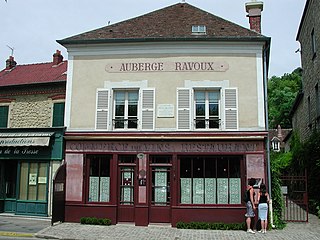
The Auberge Ravoux is a French historic landmark located in the heart of the village of Auvers-sur-Oise. It is known as the House of Van Gogh because the Dutch painter Vincent van Gogh spent the last 70 days of his life as a lodger at the auberge. During his stay at Auvers, Van Gogh created more than 80 paintings and 64 sketches before shooting himself in the chest on 27 July 1890 and dying two days later on 29 July 1890. The auberge (inn) has been restored as a museum and tourist attraction. The room where Van Gogh lived and died has been restored and can be viewed by the public.

Landscape with Pollard Willows is an oil painting created in April 1884 by Vincent van Gogh.

The death of Vincent van Gogh, the Dutch post-Impressionist painter, occurred in the early morning of 29 July 1890, in his room at the Auberge Ravoux in the village of Auvers-sur-Oise in northern France. Two days earlier, Van Gogh shot himself or was intentionally or accidentally shot by someone else. While his death certificate states that he died as a result of suicide, at least two biographers have challenged that, saying he may have been intentionally or accidentally shot by someone else.
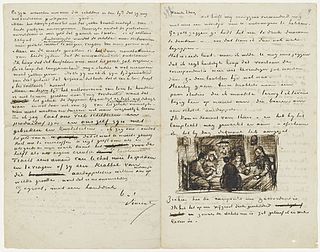
The Letters of Vincent van Gogh is a collection of 903 surviving letters written (820) or received (83) by Vincent van Gogh. More than 650 of these were from Vincent to his brother Theo. The collection also includes letters van Gogh wrote to his sister Wil and other relatives, as well as between artists such as Paul Gauguin, Anthon van Rappard, and Émile Bernard.
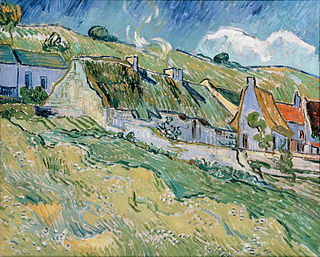
Thatched Cottages and Houses is an oil painting by Vincent van Gogh that he painted in May 1890 when he lived in Auvers-sur-Oise, France.

Old Vineyard with Peasant Woman is a watercolour painting by Vincent van Gogh that he made in May 1890 when he lived in Auvers-sur-Oise, France.

Adrianus Jacobus Zuyderland was Vincent van Gogh's favorite model during his Hague period. He appears in dozens of drawings, easily identified by his bald head and prominent white whiskers, and he was the model for the drawing which was the basis for van Gogh's later iconic painting At Eternity's Gate.

Tree Roots is an oil painting by Vincent van Gogh that he painted in July 1890 when he lived in Auvers-sur-Oise, France. The painting is an example of the double-square canvases that he employed in his last landscapes.

View of the Asylum and Chapel of Saint-Rémy is an oil on canvas painting by Vincent van Gogh that he painted in autumn 1889 at Saint-Rémy, France, where he had voluntarily incarcerated himself in a lunatic asylum.

Memory of the Garden at Etten (Ladies of Arles) is an oil painting by Vincent van Gogh. It was executed in Arles around November 1888 and is in the collection of the Hermitage Museum. It was intended as decoration for his bedroom at the Yellow House.
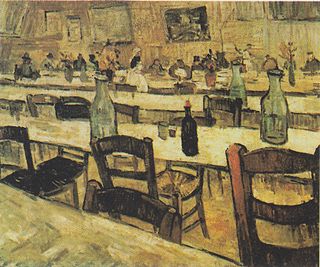
Interior of a Restaurant in Arles is a colored oil painting by Dutch artist Vincent van Gogh on an industrially primed canvas of size 25 (Toile de 25 figure) in Arles, France, late August, 1888.

Boats du Rhône is a series of two sketches and three oil paintings, listed below, created by the Dutch artist Vincent van Gogh while living in Arles, France, during August, 1888.

Houses at Auvers is an oil painting by Vincent van Gogh. It was created towards the end of May or beginning of June 1890, shortly after he had moved to Auvers-sur-Oise, a small town northwest of Paris, France.

Landscape at Auvers in the Rain is an oil on canvas painting by the Dutch Post-Impressionist painter Vincent van Gogh.
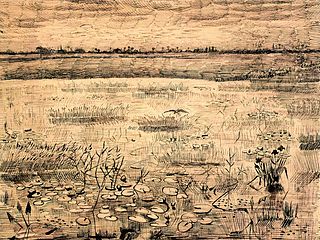
Marsh with Water Lilies is a drawing by Vincent van Gogh. It was executed at Etten in June 1881.




















